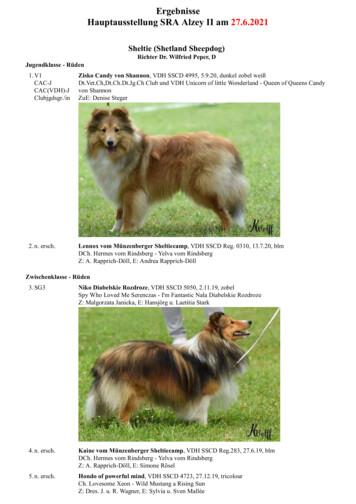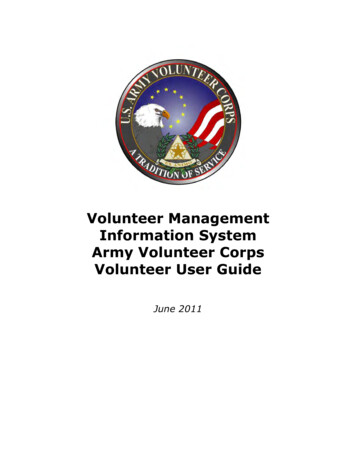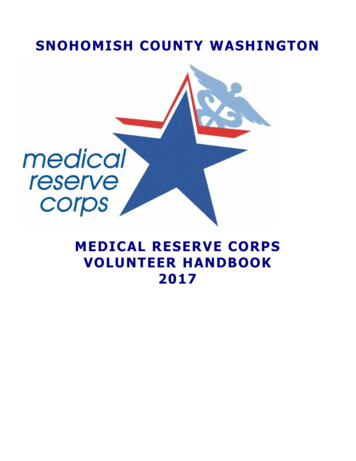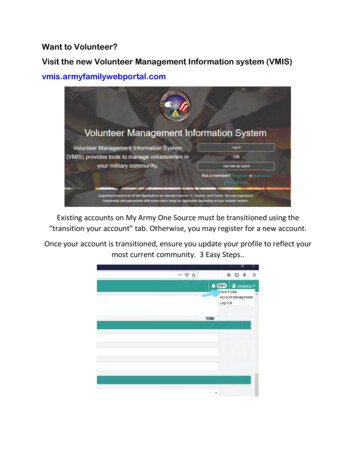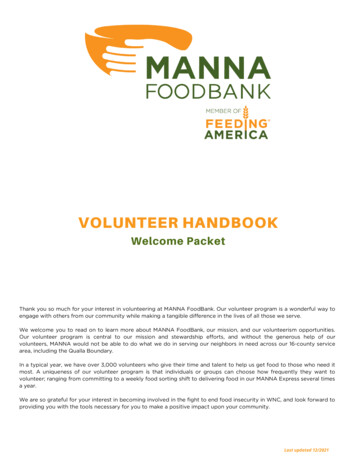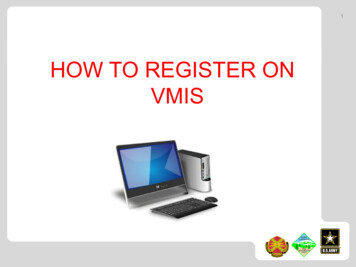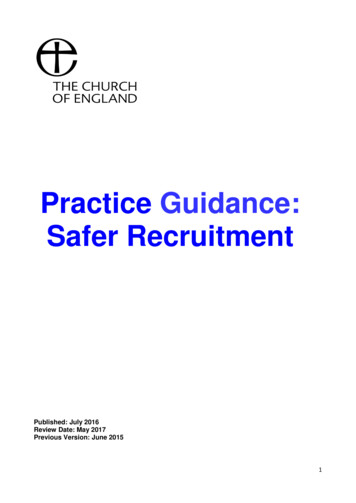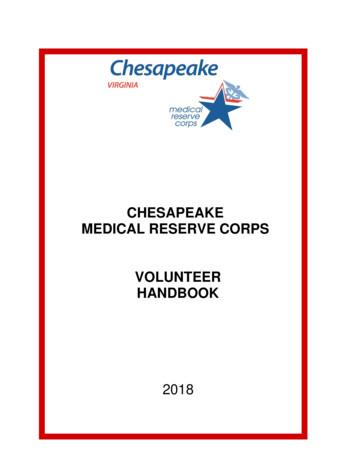
Transcription
CHESAPEAKEMEDICAL RESERVE CORPSVOLUNTEERHANDBOOK2018
CMRC Volunteer HandbookTable of Contents1. Introduction22. MRC Activation/Mobilization23. Organization44. ID Badges55. Uniforms and Equipment66. HIPAA77. Training88. Assignments119. Communications1110. CMRC Volunteer code of Conduct1111. Resources12AppendicesAppendix A – Volunteer AppearanceAppendix B – CMRC Volunteer BadgeAdd other appendices here 1314CMRC Volunteer Handbook V0613 1
CMRC Volunteer HandbookCHESAPEAKE MEDICAL RESERVE CORPSVOLUNTEER HANDBOOKIntroductionMission: The mission of the Chesapeake MRC is to organize and train local medical,health and community volunteers to support and/or supplement existing medicalemergency and public health response efforts in the City of Chesapeake. Membership: Members of the Chesapeake Medical Reserve Corps arevolunteers. Volunteers can be either licensed medical professionals or nonmedical support personnel. Volunteers support routine health activities to keepcurrent with public health functions and services in preparation for disasterneeds.MRC Activation/Mobilization Activation of the Chesapeake MRC1) The CMRC is a local resource intended to assist the City of Chesapeake in itsresponse to large-scale local emergencies and priority public health concerns.2) The CMRC operates within the Incident Command System (ICS), under theoperational control of the Health Department when responding to emergencysituations.3) The CMRC volunteers will only be used in functional areas or givenassignments for which they are properly trained and equipped. Activation Authority1) The Chesapeake MRC will be activated by the CHD Director, CMRC Director/Chesapeake Health Department (CHD) Emergency Coordinator or his/herdesignee.2) As a local emergency medical resource, the Chesapeake MRC may berequested by:a) CHD Directorb) CMRC Director/ Chesapeake Health Department (CHD) EmergencyCoordinatorc) Local government elected officials, officials responsible for emergencymanagement or public health, or their designated representativesd) Incident commanders in the fielde) Hospital chief executive officers, emergency department directors or theirdesignated representatives in the fieldCMRC Volunteer Handbook V0613 2
CMRC Volunteer Handbook 3) The CMRC Director/Emergency Coordinator and the CMRC Coordinator (ortheir designees) will obtain the following information from the officialrequesting the activation of the MRC:a) The nature and scope of the emergencyb) The location of the emergencyc) The estimated number of patients and their injuriesd) The staging area(s) or location(s) to which the MRC unit should deploye) Specific medical skills and/or resources needed, i.e., physicians, nurses,EMTs, etc.f) A contact phone number and/or radio frequencyg) Reporting authority of supervisor4) Approved requests are forwarded by the CMRC Director/CHD EmergencyCoordinator, to the CMRC Coordinator for notification of volunteers.5) Activated CMRC volunteers will be told upon activation where to assemble fordeployment.6) Once on the scene, Chesapeake MRC volunteers will check in with theAdministrative Officer/Staff and Volunteer coordinator. Volunteers will thenbe integrated into the emergency activity or operation effort.Operations1) A primary function of the CMRC is to provide medical and non-medicalpersonnel to support a mass immunization or prophylaxis distribution effortconducted by the Health Department.2) Volunteers may be requested to augment the Public Health staff withadministering vaccines and medication, conduct screening and patienteducation, records maintenance, provide emergency medical response topatients with potential vaccine reactions, and support of any additional directmedical activities, in accordance with the each volunteer’s training andcredentials.3) In operations involving the deployment of the Strategic National Stockpile(SNS), CMRC pharmacists, pharmacy technicians and other volunteers mayassist the Health Department in the reformulations and breakdown of bulkpackages to smaller, patient specific prescriptions. In the event of an SNSdeployment, CMRC volunteers will operate under the guidance of local,regional, and national bioterrorism response plans.4) When needed, the Chesapeake MRC may assist the District HealthDepartment with the investigation and control of communicable diseaseoutbreaks. CMRC volunteers will work with the Public Health Response Teamunder the Direction of the Health Director and Epidemiologist. Volunteers willoperate within the procedures used to investigate outbreaks of communicablediseases described in the VDH (Virginia Department of Health)Communicable Disease Manual.5) In the event of natural disasters which threaten food and water supplies, theChesapeake MRC may assist the emergency relief efforts of the FireDepartment or other city agency, as assigned by the Director.CMRC Volunteer Handbook V0613 3
CMRC Volunteer Handbook6) The CMRC may participate in specific public health initiatives in coordinationwith the CHD Liaison. These may be established public health programs, inwhich case the CHD will provide JITT (Just in Time Training) and supervisionto volunteers who participate in ongoing public health programs. Demobilization of CMRC1) CMRC volunteers may support emergency medical, public health, and otherpersonnel for the duration of an incident or as long as their assistance isrequired. It is possible that some CMRC personnel and resources will bedemobilized before others as their assignments are completed.2) CMRC volunteers will demobilize along with other on-scene personnel andresources, in accordance with the Incident Action Plan and/or the IncidentCommander’s instructions.3) When demobilizing, CMRC volunteers should ensure the following actions areaccomplished:a) Ensure all assigned activities are completed.b) Determine whether additional assistance is required.c) If within the scope of one’s assignment, help ensure all injured personneland fatalities are properly processed and transported to appropriatefacilities.d) Account for all CMRC equipment (if any).e) Clean up any debris or trash associated with CMRC assignments.f) Check out with Incident Commander or Resource Unit prior to leavingincident.Organization The Chesapeake Medical Reserve Corps is organized under the ChesapeakeCitizen Corps Council with oversight provided by the LEPC/CCC CMRC WorkingGroup. Program direction and operational control are provided by theChesapeake Health Department through the Emergency Coordinator who alsoserves as the CMRC Director.Day-to-day administration is provided by the CMRC Program Coordinator.The organizational structure is composed of the following persons:CMRC Volunteer Handbook V0613 4
CMRC Volunteer HandbookChesapeake Health Dept.DirectorChesapeake MRCDirector/Emergency PlannerChesapeake MRC CoordinatorID Cards or Badges (Appendix B) The CMRC Coordinator will manage the issuance of identification cards to unitvolunteers. All ID cards must be returned to the CMRC Coordinator oncemember affiliation is terminated with the organization.Active CMRC Volunteers will be issued the following ID Badges:1)2)3)4)5)Red Striped ID Card designates medical volunteers: physicians.Blue Striped ID Card designates medical volunteers: RN, LPN, CNA, etc.Purple Striped ID Card designates EMT’sGreen Striped ID Card designates non-medical volunteers.Orange Striped ID Cards designate volunteers with License Clinical SocialWorker(LCSW) experience.All three identification cards will:CMRC Volunteer Handbook V0613 5
CMRC Volunteer Handbooka) Identify unit volunteers as members of a recognized emergency medicalresponse organization. Identify individual volunteers as members of theCMRC.b) Provide Chesapeake MRC volunteers with access to the scene of anemergency as part of the region’s emergency medical response system.Uniforms and Equipment Uniforms1) CMRC volunteers are issued red uniform polo shirts with the CMRC logoembroidered on the left side of the chest, lanyard with badge, and redbackpack upon completion of the CMRC Administration and TrainingRequirements. Refer to CHD Volunteer Appearance Guidelines.2) Wearing CMRC uniforms by volunteers serves several purposes:a) Clearly identifies volunteers as official members of the CMRC.b) Enhances esprit de corps of MRC volunteers and facilitates a professionalappearance.c) Establishes a visual link between the CMRC and other participatingagencies3) Only members of the CMRC are authorized to wear the officialChesapeake MRC polo-shirts.4) The CMRC uniform is worn during emergency response activities and whenmembers are performing non-emergency duties serving the community.5) The CMRC shirt should also be worn by Chesapeake MRC members duringexercises, other training activities or events.6) If for any reason a volunteer resigns or is dismissed from theCMRC, they must return their shirt to the CMRC Coordinator or theirdesignee. The shirt is then destroyed.7) For safety and health reasons, a used shirt is not laundered and passedalong nor recycled for another member. Equipment1) CMRC ball caps are available for CMRC volunteers. However, these hatsare not a required piece of equipment.2) CMRC Backpacks should contain first aid suppliesand other necessities. It is recommended that each volunteer keep theirbackpack available in case of an emergency situation.Backpacks may contain items such as:a) Change of clothes (clothes for variant weather)b) Change of shoes and socksc) Toiletries: toothbrush/toothpaste, hairbrush, etc.d) Flashlight and batteriese) Reminder note to bring any needed daily medicationCMRC Volunteer Handbook V0613 6
CMRC Volunteer Handbookf) Reminder note to bring Identification, MRC ID badge, etc., and othernecessities CMRC or CHD vests may be distributed to volunteers on-site during anemergency or training drill. These vests must be worn as directed and returnedprior to leaving facility after completing given assignment.CMRC Emergency Vest(Front and Back)Health Information Portability and Accountability Act (HIPAA) While serving as a MRC volunteer, you will have access to the Protected Healthinformation (PHI) of patients. The fact that an individual is or was a patient during anincident is PHI.1) Federal and state laws, including HIPAA and our policies and procedures,protect the privacy and security of this PHI.2) It is illegal for you to use or disclose PHI outside the scope of your volunteerduties for the CMRC. This includes oral, written, or electronic uses anddisclosures.3) Guidelines for the use of PHI as a CMRC volunteer is as follows:a) You may access PHI as necessary to carry out your duties as a volunteer.b) You may share PHI with other healthcare providers for treatmentpurposes.c) You may not photocopy PHI.d) You must access only the minimum amount of PHI necessary to care for apatient or to carry out an assignment.CMRC Volunteer Handbook V0613 7
CMRC Volunteer Handbooke) You may not keep any PHI record PHI (such as patient names, diagnoses,dates of birth, addresses, phone numbers, etc.) from any assignments.You will need to turn all PHI forms prior to departing your assignment.f) You may only access the PHI of patients for whom you arecaring/volunteering when there is a need for the PHIg) Be aware of your surroundings when discussing PHI. For example,because others may overhear you, it is inappropriate to discuss PHI inbathrooms, lunch areas, or in any other public place.h) When disposing of documents with PHI, do not put them into a waste can.Instead, place discarded documents with PHI into containers marked forshredding and proper disposition.i) If you have any questions about the use or disclosure of PHI, contact theCMRC Program Coordinator or the VDH HIPAA Compliance and PrivacyOfficer:Marian VollmerCHD. HIPAA Compliance OfficerNurse Manager748 Battlefield Blvd., North Chesapeake,VA 23320Email: Marian.Vollmer@vdh.virginia.govPhone: 757-382-8640TrainingRequired TrainingAdd hyperlinks Once applicants have registered for membership in the CMRC, they will have theopportunity to participate in an Orientation. This Orientation session is required, as itcontains valuable information on areas such as:1) Familiarization with the Mission of the MRC2) Understanding the Potential Volunteer Roles3) Knowledge of available training needs and opportunities4) Understanding of steps required to be prepared for potential assignmentThe Federal Emergency Management Agency (FEMA) offers a selection of independentstudy courses, three of which are required for CMRC volunteers. The course names arelisted as followsICS-100b: http://training.fema.gov/emiweb/is/is100b.asp Introduction to the Incident Command SystemCMRC Volunteer Handbook V0613 8
CMRC Volunteer HandbookThis course is designed to give an introduction to the principles, commonterminology and position responsibilities when responding to an event using theIncident Command System. The course specifically discusses major ICSfunctions and their primary responsibilities, ICS organizational units, span ofcontrol, major incident facilities and the function of each, what an Incident ActionPlan is and how it is used, and the common responsibilities associated withincident assignments from the Federal disaster response workforce perspective.IS-700a: http://training.fema.gov/emiweb/is/is700a.asp National Incident Management System (NIMS), An Introduction (3 hours) or onthe FEMA Emergency Management Institute’s Independent Study Program. OnFebruary 28, 2003, President Bush issued Homeland Security PresidentialDirective-5. HSPD-5 directed the Secretary of Homeland Security to develop andadminister a National Incident Management System, or NIMS. NIMS provides aconsistent nationwide template to enable all government, private-sector, andnongovernmental organizations to work together during domestic incidents. Thiscourse introduces NIMS and explains the purpose, principles, key componentsand benefits of NIMS.Points of Dispensing (POD) Training (15 minute ng.htm This course provides an overview of the StrategicNational Stockpile (SNS) response in providing medications and equipment in case ofa bioterrorism attack in the Hampton Roads area; the role of Public Health staff andvolunteersOptional Leadership Training ICS-22: Are You Ready? An In-depth Guide to Citizen Preparedness has beendesigned to help the citizens of this nation learn how to protect themselves andtheir families against all types of hazards. It can be used as a reference source oras a step-by-step manual. The focus of the content is on how to develop,practice, and maintain emergency plans that reflect what must be done before,during, and after a disaster to protect people and their property. Also included isinformation on how to assemble a disaster supplies kit that contains the food,water, and other supplies in sufficient quantity for individuals and their families tosurvive. Cities Readiness Initiative (CRI) Dispensing Site Training/Strategic National StockpileTraining, Parts I and II (2 hours). This course includes a review of the ICS System,detailed descriptions some key jobs and stations, description of clinic flow and clinicalgorithms, a general overview of the Strategic National Stockpile (SNS), operations ofa Point of Dispensing Site (POD), operation of a special residential delivery ofmedications, and the CMRC volunteer’s role.CMRC Volunteer Handbook V0613 9
CMRC Volunteer Handbook Participation in a Mass Dispensing Exercise (Special Delivery/Point of Dispensing(POD). A mass dispensing exercise tests the effectiveness of a POD. Specifically, theexercise tests the Chesapeake Health Department’s (CHD) ability to respond in a timelyand organized manner to a bioterrorism attack or a disease outbreak. The CHD duringthese exercises must set up PODs and deliver medications to the “affected community”using the “push” or “pull” methods. The push method sends medications out to thepopulation; the pull method brings the patients into a POD which is a designated“alternate” care place other than the CHD. The exercises tests the delivery and timingof either method, such as staffing, method of dispensing medications, number ofpatients served, patient flow, dissemination of public information, data collection,communications among participants, ability to work in a team, etc. Additionally, it teststhe response to the call for participation, the integration and assignments of CMRCvolunteers. Exercises will include organizations potentially affected by the type ofscenario or response being exercised, i.e. agencies at all levels of government,businesses and charitable and community organizations. Participating in exercises is aninvaluable means for Chesapeake MRC volunteers to use and test their training andknowledge. Exercises will be available on an annual basis in which MRC volunteerscan participate.Training Records The CMRC shall maintain training records on all volunteers in VVHS and or TRAINVirginia.1) Once a CMRC member has completed the orientation session, received abackground investigation, completed the three FEMA IS courses (IS- 100.b, IS700.a, and PODs), he/she will be considered a fully trained CMRC member.2) CMRC volunteers must ensure their training and volunteer hour records arecurrent. All records in VVHS and or TRAIN Virginia as well as the in-house hardcopy files will be updated to reflect the completion of individual and CMRCtraining, exercises and deployments.CMRC Assignments Volunteers will be assigned to a certain role with specific responsibilities dependingon their medical level, and experience. Prior to serving, volunteers will receive dutyinstructions to be able to complete the given task. In addition to routine procedures,in an emergency, volunteers would also receive a job action sheet outlining the rolesand responsibilities.CommunicationsCMRC Volunteer Handbook V0613 10
CMRC Volunteer Handbook Official Communications during exercises or real events may use a variety ofcommunication methods. Land Telephone Lines, Cell Phones, 800 MHz Radios,Two-way “walkie-talkie” radios, Satellite phones, HAM radios, etc. Issuance ofspecialized communication equipment will be event-driven.Emergency Two-way RadiosCMRC Volunteer Code of Conduct ExpectationsIn general, it is expected that CMRC members will comply with the followingstandards of behavior:1) Adherence to all local, state, and Federal laws at all times2) Adherence to applicable safety standards3) Professional conduct and appearance while participating in any MRCrelated activity (Refer to CHD Volunteer Appearance Guidelines)4) Adherence to the chain of command, both within the local MRC unit andin an IncidentCommand System established in an emergency5) Clear display of current identification and unit affiliation while on duty Dismissal1) Dismissing a volunteer may be necessary when behavior does notcompromise the safety of volunteers, response partners, or communitymembersResourcesWebsites:CMRC web site: www.vdh.virginia.gov/mrc/CHD Facebook Page: www.facebook.com/ChesapeakeHDNational Medical Reserve Corps: http://www.medicalreservecorps.govCMRC Volunteer Handbook V0613 11
CMRC Volunteer HandbookWebsite of Medical Reserve Corps located in Virginia:http://www.vdh.virginia.gov/mrc/Federal Emergency Management Agency (FEMA): http://www.fema.govFEMA Independent Study Course/Training t.aspHIPAA Information: http://www.hhs.gov/ocr/hipaa/Contact Information for the Chesapeake MRC Program Coordinator:Chesapeake Health Department748 Battlefield Blvd., NorthChesapeake, VA 23320-4914Attn: Medical Reserve Corps CoordinatorEmail: ChesapeakeMRC@vdh.virginia.govOffice Phone: (757) 382-8719Fax: (757) 382 - 8704CMRC Volunteer Handbook V0613 12
CMRC Volunteer HandbookAPPENDIX ACMRC Volunteer AppearanceAdd Volunteer Appearance policy here Chesapeake Health Department Volunteer AppearanceThis policy as it applies to the volunteers of the Chesapeake HealthDepartment/Chesapeake Medical Reserve Corps (CMRC) is designed to provide a safe andprofessional environment to both clients and employees of the Chesapeake HealthDepartment.All questions and concerns should be brought to the attention of the VolunteerCoordinator, Chesapeake Medical Reserve Corps. Please contact at 757-382-8719 or atChesapeakeMRC@vdh.virginia.gov.APPROPRIATE ATTIRE Volunteers should maintain an appearance that is neat, clean, and appropriate to thebusiness environment. If you have completed all mandatory training, and earnedyour MRC polo, please wear that to all events unless directed otherwise. Volunteer identification should be readily visible whenever interacting with thepublic. Please wear your MRC badge at all times when deployed. Hair should be clean, combed, and/or neatly trimmed or arranged. Sideburns, moustaches and beards should be neatly trimmed. Accessories should not pose a safety risk, detract attention from the workenvironment or interfere with the performance of an employee’s workresponsibilities. Cologne, perfume, and aftershave or other fragranced products should be subtle.Volunteers should take into consideration that some individuals may be sensitive to,or have an allergic reaction to certain fragrances. Shoe selection should be appropriate to the work assignment. Shoes withexcessively high heels are discouraged.o In the clinic areas, open-toed or permeable shoes are not permitted.o For outdoor or physical activities, closed-toed shoes that provide propersupport are a must. In clinic areas, no artificial nails (of any type), acrylic, or chipped polish are allowedas they support fungal and/or bacterial growth.INAPPROPRIATE ATTIRE including but not limited to items listed below: Fatigues, sweatpants, exercise pants, short-shorts, bib overalls, leggings, spandex, orany other form-fitting pants.CMRC Volunteer Handbook V0613 13
CMRC Volunteer Handbook Short dresses or skirts. All dresses/skirts must be no shorter than 3 inches abovethe top of the kneecap.Visible Undergarments. Clothing that is revealing and/or sheer enough to seeundergarments should be worn with a slip, camisole or other cover.Revealing, tight fitting clothing – Strapless, spaghetti-strap, excessively low cut, offthe shoulder, or visible midriff. (Do not forget to check for “bending over” changes.)Multicolored hosiery or hosiery with bold designs or designs with holes such asfishnets or windowpanes is prohibited.No logo garments other than CHD, VDH, or MRCDirty/Wrinkled clothesBody piercings (with the exception of earrings worn in the ear) that is visible.Graphic/disturbing accessories or body art, e.g., displaying violence, drugs, sex,alcohol, racial or ethnic slurs, profanity, weapons, or other potentially offensiveimages.CMRC Volunteer Handbook V0613 14
APPENDIX BCMRC Code of EthicsCMRC Volunteer HandbookCMRC Volunteer Handbook V0613 15
APPENDIX CCMRCCMRC Identification Card/BadgeVolunteer HandbookCMRC Volunteer Handbook V0613 16
CMRC Volunteer HandbookAPPENDIX DMonthly Volunteer Hours & Activity SheetCMRC Volunteer Handbook V0613 17
CMRC Volunteer HandbookCMRC Volunteer Handbook V0613 18
CMRC Volunteer Handbook CMRC Volunteer Handbook V0613 1 Table of Contents 1. Introduction 2 2. MRC Activation/Mobilization 2 . The CMRC operates within the Incident Command System (ICS), under the . The Federal Emergency Management Agency (FEMA) offers a selection of independent study courses, three of which are required for CMRC .
